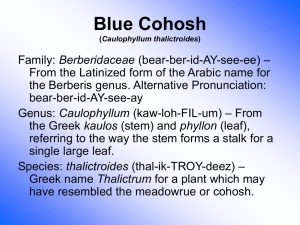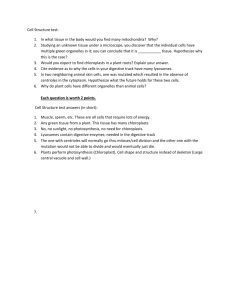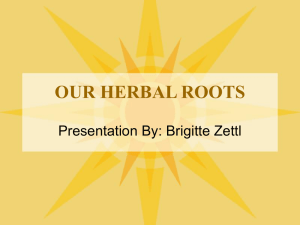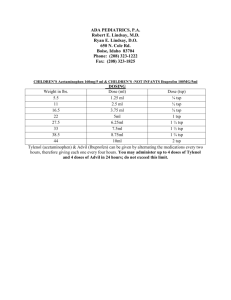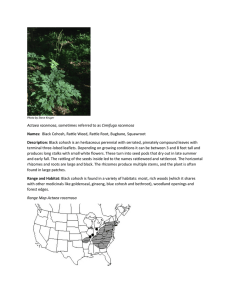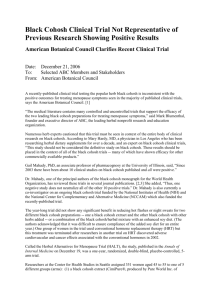13.2-Materia-Medica - Urban Moonshine Herb School
advertisement
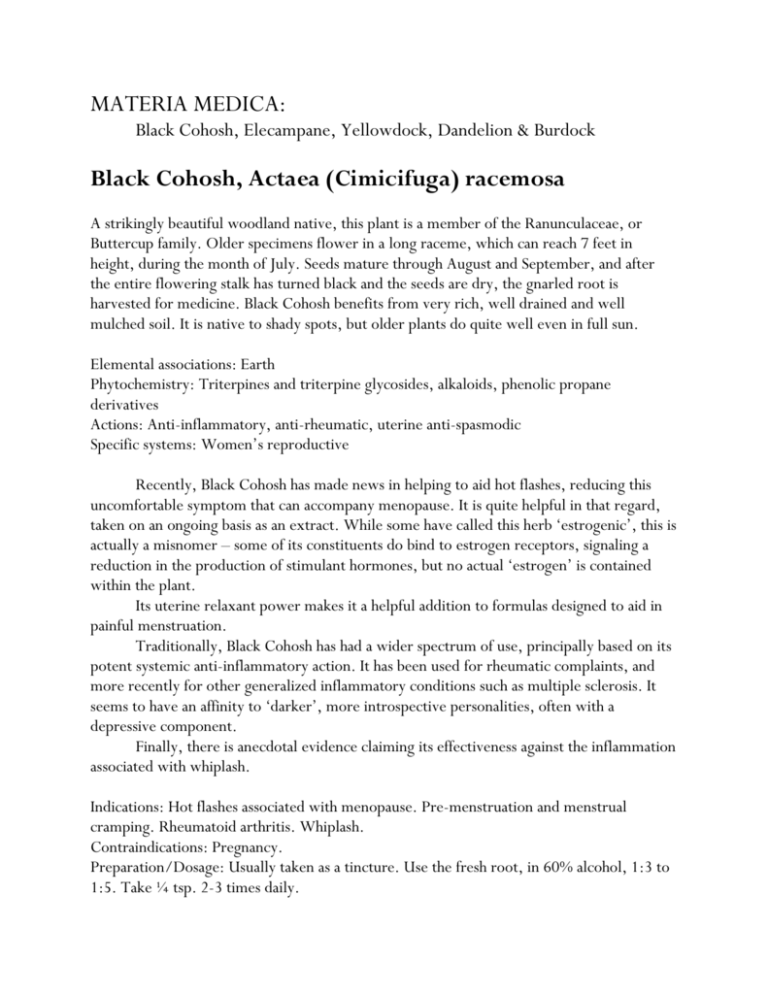
MATERIA MEDICA: Black Cohosh, Elecampane, Yellowdock, Dandelion & Burdock Black Cohosh, Actaea (Cimicifuga) racemosa A strikingly beautiful woodland native, this plant is a member of the Ranunculaceae, or Buttercup family. Older specimens flower in a long raceme, which can reach 7 feet in height, during the month of July. Seeds mature through August and September, and after the entire flowering stalk has turned black and the seeds are dry, the gnarled root is harvested for medicine. Black Cohosh benefits from very rich, well drained and well mulched soil. It is native to shady spots, but older plants do quite well even in full sun. Elemental associations: Earth Phytochemistry: Triterpines and triterpine glycosides, alkaloids, phenolic propane derivatives Actions: Anti-inflammatory, anti-rheumatic, uterine anti-spasmodic Specific systems: Women’s reproductive Recently, Black Cohosh has made news in helping to aid hot flashes, reducing this uncomfortable symptom that can accompany menopause. It is quite helpful in that regard, taken on an ongoing basis as an extract. While some have called this herb ‘estrogenic’, this is actually a misnomer – some of its constituents do bind to estrogen receptors, signaling a reduction in the production of stimulant hormones, but no actual ‘estrogen’ is contained within the plant. Its uterine relaxant power makes it a helpful addition to formulas designed to aid in painful menstruation. Traditionally, Black Cohosh has had a wider spectrum of use, principally based on its potent systemic anti-inflammatory action. It has been used for rheumatic complaints, and more recently for other generalized inflammatory conditions such as multiple sclerosis. It seems to have an affinity to ‘darker’, more introspective personalities, often with a depressive component. Finally, there is anecdotal evidence claiming its effectiveness against the inflammation associated with whiplash. Indications: Hot flashes associated with menopause. Pre-menstruation and menstrual cramping. Rheumatoid arthritis. Whiplash. Contraindications: Pregnancy. Preparation/Dosage: Usually taken as a tincture. Use the fresh root, in 60% alcohol, 1:3 to 1:5. Take ¼ tsp. 2-3 times daily. Elecampane, Inula helenium This very warming, spicy plant is a member of the Aster family, the Compositae. It flowers tall and quite beautifully from its large basal leaves, in clusters of yellow flowers with long, stringy petals. We collect its roots in late September and October, once the seed is completely dispersed. It does quite well in any soil type, although it prefers moisture and will make good use of any extra fertility it is given. Elemental associations: Air Phytochemistry: Volatile oil (sesquiterpene lactones), polysaccharides (especially inulin) Actions: Expectorant, anti-bacterial, diaphoretic, demulcent Specific systems: Respiratory Elecampane is quite simply one of the best expectorants we know. It is strong in action however, and if the constitution is weak a gentler effect can be obtained with herbs like Mullein and Licorice. However, this herb should always be considered both in cases of acute pulmonary congestion and/or infection, and to help loosen stubborn, chronic coughs. It also helps soothe mucus membranes with its inulin and mucilage content. Amongst the ‘docks’, or large-leafed, weedy plants prized for their roots, Elecampane has a special affinity to the more ‘unseen’ realms, being called ‘elf dock’, gathered and carried to aid in the second sight. This is echoed in its elemental association. Indications: Bronchitis, Tuberculosis, Pneumonia, chronic chest congestion / cough Contraindications: Pregnancy Preparation/Dosage: A decoction can be made from the root, fresh or dry, although its flavor will be quite intense and might require a little honey. However, its bitterness can also help stimulate appetite in the patient! Use 3 TBS. Per pint of water. The tincture is also quite effective, taken in some warm water. Use ½ tsp. 3-5 times daily in an acute situation; half that for chronic conditions. Yellowdock, Rumex crispus This common weed is a member of the Buckwheat family, the Polygonaceae. It flowers in July, and its seed is usually set in a dark brown by the end of August. We harvest it for its root, usually in the fall, although it is quite good in the spring as well, and juicier. Although it grows quite well anywhere, it does prefer a bit of richness in the soil, and we cultivate it to ensure big, easy-to-dig roots. Elemental associations: Air Phytochemistry: Anthraquinones, bitter principles, tannins Actions: Aperient, alterative, cholagogue Specific systems: Digestive This bitter remedy is an excellent tonic for the lower digestive system, helping to loosen and move the bowels and stimulate appetite and digestion. Its gentle action should make it a first choice in treatments designed to address constipation. Yellowdock goes further, however. It is a mild alterative, helping to remove toxins from the bloodstream by stimulating the release of bile from the liver. It therefore helps not only in eliminating congested waste from the colon, but also the resultant backup of blood toxicity. Indications: Constipation, atonic bowel Contraindications: None really – overuse can result in diarrhea Preparation/Dosage: The decoction can be made with 1 ½ TBS. of the root in one pint of water. Take 15 minutes before dinner. The tincture, prepared at 40%, 1:4, is taken 15 minutes before meals, ¼ tsp. Dandelion, Taraxacum officinale Everyone knows this bright member of the Aster family, the Compositae. It begins to flower in late May, turning into the familiar puffballs and scattering its prolific seed to the wind. We harvest the most tender leaves as a Springtime tonic, but really its greens are excellent all through the year. The flowers are a good food source, cooked in fritters or in a stew. The root is harvested in the fall (a bit too watery in the spring). Like other ‘weedy’ plants, it grows almost everywhere – but we let it find a home in rich garden beds here and there, so that nice, fat roots can develop. Elemental associations: Air Phytochemistry: Triterpenioids, bitter principles, inulin, choline, potassium Actions: Leaves: Diuretic, urinary tonic. Roots: Cholagogue, alterative, tonic Specific systems: Leaves: Urinary. Root: Digestive, general tonic The Dandelion is a powerful herb. It is also extremely safe. Most of its cooling power focuses itself on the liver (root) and the kidneys (leaf), and although the individual parts of the herb work well on those respective systems, the combination of the two provides for improved detoxification and smoother, safer action. Its action on the liver is remarkable, and well documented. It is an essential ingredient of any hepatitis treatment, along with Milk Thistle, to help safeguard and heal the liver. It is also an excellent gallbladder remedy, stimulating the release of bile from this organ and promoting the release of stones. Again, a well-functioning gallbladder serves to keep the body cleansed of toxins. The leaf is probably the best herbal diuretic available. It helps and stimulates the kidneys to release more water from the system, clean the blood and fluids, and is also excellent to heal edema and alleviate the symptoms of the ‘dropsy’, or congestive heart failure. Unlike other diuretics (pharmaceuticals lead the list here), Dandelion gives the body a net gain of Potassium, because there is more of this important mineral present in the herb than in the water that leaves the body through the kidneys. For this reason, this herbal diuretic will not aggravate high blood pressure or put extra strain on the heart. In fact, it is and excellent aid to relieve hypertension. As an herbal ‘bitter’, Dandelion stimulates gastric secretions in the stomach that aid in smooth and complete digestion. Along with this comes increased absorption of nutrients and a decrease of toxic by-products: another powerful cleansing action. Another virtue of bitters is their ability to decrease the swings in blood sugar some people can experience after (or before) a meal. It is sometimes ironic that a plant so widespread and despised might be an answer to modern life’s many toxic threats; conversely, it is a great example of how Nature around us stubbornly provides for what we need. I think it underlines the love and connection life shows on this planet: even amidst the constant stream of pollutants we burden it with, the Earth provides a simple remedy to protect us from our own waste. Indications: Root: Debility, digestive weakness, hepatitis, hypoglycemia, diabetes. Leaves: Hypertension, edema, kidney problems (deficiency and congestion) Contraindications: Absolutely none. Preparation/Dosage: Leaf tea, infusion of 4 TBS per pint of water. Root decocted, 3 TBS per pint of water. Tincture of the leaf, 40%, 1:4 , ¼ tsp. 3 times daily. Of the root: 4050%, 1:3 to 1:5, taken ½ tsp. 2-3 times daily before meals. Burdock, Arctium lappa This is the ‘greater dock’, a member of the Aster family, the Compositae. Its leaves can get gigantic in the right soil, and in the fall it sends up a stalk with many thistle-like flowers that quickly turn into barbed ‘burrs’ that love to latch on to hair and clothes. We harvest the root in the fall, usually from first or second year plants as the root becomes quite branched and hard to handle after that. Elemental associations: Water Phytochemistry: Bitter principles, flavonoids, alkaloids, inulin Actions: Alterative, cholagogue Specific systems: Digestive, skin Burdock has a set of actions which all relate to ‘moving’, or clearing. It is gentle, too, and accomplishes its tasks with a downward-trending, cooling energy, which resembles the growing pattern of its root as it digs deep into moist soil. To begin with, its bitter qualities have an immediate benefit on the stomach, but it doesn’t stop there. Burdock gently works on the liver and gallbladder, promoting the secretion of bile, thus helping to eliminate residual toxins from our bodies and encouraging smooth digestion. This ability to aid in the body’s detoxifying process is again echoed in its traditional description as a blood cleanser, with the power to resolve latent infections, and help clear up eruptions of toxic blood on the skin’s surface. A good, long-term regimen of Burdock tea or extract is usually indicated for acne, and even eczema and other chronic rashes. The seed can be added, too. Our kidneys are constantly filtering liquids from our blood, lymph and other body systems and eliminating harmful toxins from these fluids. If the kidneys are weak, and the body is having difficulty with its water balance, Burdock’s clearing power can help reduce the burden of toxins shouldered by the kidneys, protecting them and aiding in recovery. Deep nourishment follows its cleansing action, which is very good when we consider that mal-absorption of nutrients is most often linked to a buildup of toxins and/or a sluggish digestive system. Burdock first gently prepares the way, then provides the body with a rich array of minerals dug from deep beneath the topsoil, easily absorbable long-chain sugars, and even traces of FOS (starches our intestinal flora favors). This double action, coupled with its cooling energy, makes this one of the first herbs I think of for light cleanses and fasts, as well as for recovery from protracted illness when there is a loss of appetite and digestive function. Indications: Convalescence, skin conditions (acne, eczema, psoriasis), digestive congestion Contraindications: None really Preparation/Dosage: Decoction of the root, 3 TBS in a pint of water, taken twice daily. The tincture can be made from the fresh or dry root, 40%, 1:3 to 1:5. Take ½ tsp. 2-3 times daily before meals.
